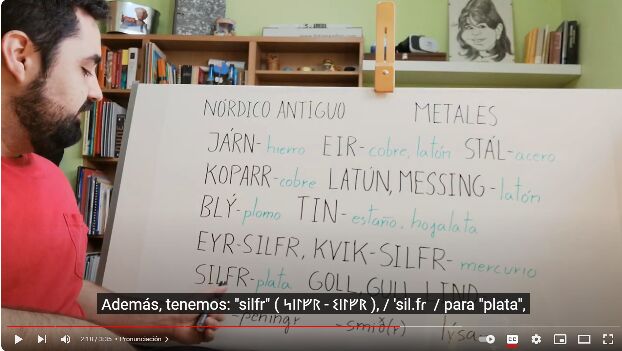| S |

BRENNI-STEINN |

BRENNU-STEINN |

BRENNA-STEINN |
Hg |

EYR-SILFR |

KVIK-SILFR |

KVIKA-SILFR |
 |
| |
Younger
Furthark runes - Elder Furthark runes |
| Ag |
 |
| Au |
 |
| Cu |
 |
| Fe |
 |
| Hg |
 |
| Pb |
 |
| Sn |
 |
|
Old
Norse, Old Nordic,[1] or Old
Scandinavian is a stage of development of North
Germanic dialects before
their final divergence into separate Nordic languages. Old Norse
was spoken by inhabitants of Scandinavia and their overseas
settlements and
chronologically coincides with the Viking
Age, the Christianization
of Scandinavia and
the consolidation of Scandinavian kingdoms from about the 8th to
the 15th centuries.[2]
The Proto-Norse
language developed
into Old Norse by the 8th century, and Old Norse began to develop
into the modern North
Germanic languages in
the mid-to-late 14th century, ending the language phase known as
Old Norse. These dates, however, are not absolute, since written
Old Norse is found well into the 15th century.[3][better source needed]
Old
Norse was divided into three dialects: Old
West Norse or Old
West Nordic (often
referred to as Old Norse[4]), Old
East Norse or Old
East Nordic, and Old
Gutnish. Old West Norse and Old East Norse formed a dialect
continuum, with no clear geographical boundary between them.
For example, Old East Norse traits were found in eastern Norway,
although Old
Norwegian is
classified as Old West Norse, and Old West Norse traits were
found in western Sweden.
Most speakers spoke Old East Norse in what is present-day Denmark and Sweden. Old
Gutnish is
sometimes included in the Old East Norse dialect due to
geographical associations. It developed its own unique features
and shared in changes to both other branches.[5]
The
12th-century Icelandic Gray
Goose Laws state
that Swedes, Norwegians, Icelanders,
and Danes spoke the same
language, dǫnsk tunga ("Danish tongue";
speakers of Old East Norse would have said dansk tunga).
Another term was norrœnt mál ("northern speech").
Today Old Norse has developed into the modern North
Germanic languages Icelandic, Faroese, Norwegian, Danish, Swedish,
and other North Germanic varieties of which Norwegian, Danish and
Swedish retain considerable
mutual intelligibility while
Icelandic remains the closest to Old Norse.[6]
The approximate extent of Old Norse and related languages in
the early 10th century: Old
West Norse dialect Old
East Norse dialect Old
Gutnish dialect Old
English Crimean
Gothic Other Germanic
languages with
which Old Norse still retained some mutual intelligibility
Old
Icelandic was very
close to Old
Norwegian, and together they formed Old
West Norse, which was also spoken in Norse settlements in Greenland,
the Faroes, Ireland, Scotland,
the Isle
of Man, northwest England, and in Normandy.[7] Old
East Norse was
spoken in Denmark, Sweden, Kievan
Rus',[8] eastern
England, and Danish settlements in
Normandy. The Old Gutnish dialect was spoken in Gotland and in various
settlements in the East.
In
the 11th century, Old Norse was the most widely spoken European
language, ranging from Vinland in the West to
the Volga
River in
the East. In Kievan
Rus', it survived the longest in Veliky
Novgorod, probably lasting into the 13th century there.[8] The
age of the Swedish-speaking
population of Finland is
strongly contested, but Swedish settlement had
spread the language into the
region by the time of the Second
Swedish Crusade in
the 13th century at the latest.[citation
needed]

Approximate geographical distribution of Old Norse and related
languages at the beginning of the 10th century. In red, the
dialect of Western Scandinavian (or Old Norse itself), in orange,
the dialect of Eastern Scandinavian, in pink, Old Gutnish, in
yellow, Old English, and in green, the other Germanic languages
with which Old Norse retained a certain intercomprehension. In
blue, the Gothic dialect of Crimea.
 Younger Furthark
runes [dictionary]
Younger Furthark
runes [dictionary]
